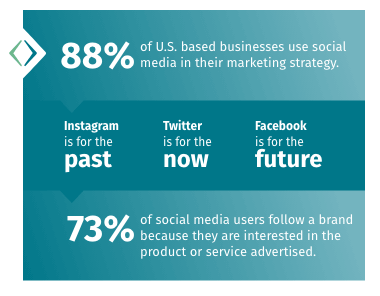 It’s the beginning of the new year and everyone in commerce is knee-deep in roadmapping exercises and industry trend articles, bringing ideas to the table for how their organization is going to keep ahead of the competition. No matter if you’re B2B, B2C, retail or service based, there is a relevant place for your brand in social media. And if you want your business to thrive in 2019, you’re going to have to muscle your brand presence into the social shopping ecosystem, find your niche, and for the love of all things one-step-checkout, MAINTAIN that presence.
It’s the beginning of the new year and everyone in commerce is knee-deep in roadmapping exercises and industry trend articles, bringing ideas to the table for how their organization is going to keep ahead of the competition. No matter if you’re B2B, B2C, retail or service based, there is a relevant place for your brand in social media. And if you want your business to thrive in 2019, you’re going to have to muscle your brand presence into the social shopping ecosystem, find your niche, and for the love of all things one-step-checkout, MAINTAIN that presence.
I know your instincts are, at this moment, telling you to hop on Instagram and create that business account, slap a logo on it, and send your office manager a quick email that there’s a fun, new task on their list of todos – but trust me when I say that you’re going to regret it. As in all things commerce, if you’re going to do something, do it the right way. You wouldn’t knowingly and willingly drive traffic to a poorly done website, right? The same rules should apply to ALL of your public facing content – even if it isn’t on your homepage. Your social media accounts act as first contact for your brand. They are the handshake that greets a potential new customer. So you have to be certain that you’re doing it the right way to make sure the first interaction, isn’t the last; harnessing attention and interest, sending users down the funnel, and turning views into conversions.
For the purpose of this article, we will be focusing on two major subject matters: what platforms to utilize (and how) for your business goals, and the general best practices of each platform to achieve those goals. Let me be clear that this blog does not address social media advertising – ONLY posting.
The first thing you should ask yourself before you begin using social media for your business is:
What Do I Want To Achieve Through Social Media?
And no, the answer can’t JUST BE be sales. You should have a set list of KPIs (link to previous blogs) that you want to accomplish. These will largely determine your specific, targeted methods. If you want to have 10,000 followers and a high average rate of engagement, your content and campaigns will be different than if your goal is to increase eCommerce sales by six percent by the third quarter. It is crucial to establish these metrics before you begin, and track on consistently.
No matter what goals you set, remember that in all incarnations, your social media presence is a direct reflection of your brand. If it’s not done well, users can make the easy and logical leap to assuming that it’s not the only thing being neglected. More than 73 percent of users on social networking platforms will follow a brand because they are interested in the product or service advertised. It’s pretty simple: with 214 billion (yes, billion) active U.S. Facebook users, three-quarters (that’s approx. 160 billion) of those users are following brands for updates, discounts, and engagement opportunities. By not maintaining a strong and consistent presence, you are selling yourself short.
So What’s The Right Way To Be Social?
We’ll start with an example, I love examples. On almost every list of brands killing it in the social media game, you’ll find Airbnb, and for good reason. This growing online marketplace maintains a universally stellar Instagram and Facebook presence, and is now the second-most-valuable US tech startup, worth $30 billion. Airbnb posts unique content to Instagram a minimum of once a day and focuses on the user, not the service. Following all basic best practices while making their content unique and targeted to their audience, as well as being an accurate reflection of who they are as a company.
It’s easy to understand the advice of “make your content about your users,” “focus on what they get, not what you’re doing,” and simply absorb that information without considering it in application. We’re not going to do that here. Follow those mantras – and we’ll do our best to help your business avoid that pitfall.
Learn From The Best
Another example? Yes, Please. Let’s use Target as easy subject matter for this point. One of their key audiences is moms who scroll through Instagram after they put the kids to bed (Is this a personal attack?). Their social game is strong. It has to be, or they will become irrelevant. The images they post are timely, professional, approachable and focus on the user.
 What does the grid to your right make you feel? I look at those images and my brain says these nine things:
What does the grid to your right make you feel? I look at those images and my brain says these nine things:
1. I love Mrs. Meyers
2. I wear casual business attire
3. OH MY GOD I want my baby to look like that
4. I want my door to look like that
5. I want to eat that
6. I want to sleep there
7. meh cards
8. SLEEPY PUUUPPY
9. THAT COULD BE ME BUYING ALL THESE THINGS IN TARGET. TARGET WILL GREATLY IMPROVE EVERY PART OF MY LIFE.
I might have a problem with Target. But you know what, EVERYONE DOES. And it’s because they have branded themselves as approach-ably put together, focusing all of their content on how shopping Target will positively impact your life.
And doing that, creating and executing your brand voice takes time and effort. So while doing social media right can be quite time consuming – writing unique content, creating engaging images and video, engaging with users, etc. – it’s worth the investment in brand equity alone. Brand awareness is vital, as is credibility – something that your eCommerce store is provided through successful social media engagement, posting and advertising.
Brand Voice
If users aren’t engaging with your social media, it’s probably because your ads sound like an advertiser, or like your grandpa wrote them. Take the time to identify who you are as a brand. What makes you different? What should compel a person to buy your product? And how are you going to communicate that in a way that makes people pay attention? Ads that speak in a unique voice with compelling content are more likely to engage. Don’t know where to start? Here are 5 steps to defining your brand voice from Content Marketing Institute.
My favorite example of this is Wendy’s renowned, and savage Twitter presence, and its capturing of the hearts of their audience. If you haven’t heard of the on-going Wendy’s vs. the world Twitter feud, well, then our lives are way better than yours.
Maybe your brand didn’t buy its pants from the sassy store – maybe this type of tone simply wouldn’t match. If you own a webstore for quilting supplies, I can’t imagine Martha of Salt Lake City would find this sarcastic, witty heat as enticing. But the point is that no matter your business, you can have a unique voice and communicate it.
What Platforms To Use & How To Use Them
Now that we have the basics, it’s time to address the platforms and individualized strategies. Scheduling the exact same content to post on every platform looks amateur. There are intricacies to optimizing content for Instagram that simply don’t apply to Facebook, etc. etc. For today I am going to only include the top five platforms: Facebook, Twitter, Instagram, Snapchat and LinkedIn.
A golden rule I like to employ is: Instagram is for the past, Twitter and Snapchat are for the now, and Facebook and Pinterest are for the future. One thing we have historically been absolutely terrible at at Human Element, is living by this principle. It is SO easy to fall into the rut of publishing a blog, creating an image, and posting it across every platform with a few hashtags you think might, kind of make sense. #ThrowbackThursday is still a thing, right?
Nope, nope, nope. This is where my ears begin to bleed. Content should be unique and optimized to each platform, even if it is a slight change for relevancy. This differentiation is primarily in 1. image size and 2. Tone. This also applies to whether or not a post should even be published to that platform. A smart tactic when you’re determining what platform a post would be relevant to is competitor comparison.
Creep on the accounts of your direct competitors, the people who offer what you offer, sell what you sell – and maybe do it better. Review those accounts for:
1. What you like and what you don’t.
2. How long the text content is for their best performing posts.
3. What hashtags were used and where – in the post or as a comment.
4. Tone: are certain descriptive words used often? Imagine what the person saying it looks like. Is it a confident, young bachelor? Or maybe your brand voice is more nurturing and maternal.
In addition, regularly check on the optimal dimensions for each platform – because size does matter. It would be a bummer if that picture you posted was in the wrong size and cut off 40 percent of the subject matter from the profile page view. Now, what you’ve all been waiting for, here are my…
Top Tips For Optimizing On The 4 Major Social Platforms:
Instagram Is For The Past
- Nostalgia: Did you pick up donuts from your friendly, neighborhood bakery on your way into the office? Ya better take a picture of the team members ravenously swarming the kitchen, shoving that fried goodness in their mouths.
- Tagging:Find the handle for the donut shop, tag them, and write timely content that focuses on the reader. Example: “Is there anything better than @susiesbakery donuts and a mid-winter morning snow?” Tagging gets your post in more places and inspires a broader audience to engage.
- Hashtags:Speaking of engagement, that timely content should also include 2-4 relevant hashtags. Additional hashtags can be used but aesthetically look better, while serving the same purpose, when added in a comment. Your post will appear in any search for #donuts if the hashtag is used in a comment. That said, be reasonable in your use of hashtags. If you want your post to rank, don’t join the competition for a hashtag with 10 million associated posts. Find something more approachable, but equally relevant.
- Links: If you’re linking to a blog or landing page, put the link in your bio, not in the post. It is not hyperlinked and it’s a pain in the ass to copy + paste a URL from the Instagram newsfeed. No one is going to do it, those who try will hate you.
Twitter & Snapchat Are For The Now
-
- Headlines: Publish a blog? Sitting in a seminar? Streaming a webinar? Tweet that. Consider Twitter your catch-all; post past, present and future relevant content – but its primary function is to communicate to your followers what is happening at the exact moment you’re tweeting. Most importantly, utilize this platform often – multiple times a day.
- Tagging and Engagement: Twitter is the OG platform for call outs and commenting. Whether you’re tweeting original content or retweeting, tag someone. Just like on IG, tagging puts your content in front of more faces.
- Hashtags: Because activity on Twitter is so hashtag heavy, it is vital to USE relevant hashtags in original content, and to regularly search for relevant hashtags and engage with the good stuff. Utilize the trending hashtags (in a relevant way) when creating content. Posts like “Check out our 30% off sale! #thoughtsandprayers” is, plain and simple, a bad idea on so many levels.
- Links: Link it uuuuup on Twitter! Just please shorten your URLs.
Facebook Is For The Future
- A Look Into The Crystal Ball: Facebook is a phenomenal platform for telling users who you are, and why it matters to them. Talk about how your target personas can engage with you off the internet; trade-shows, sales, conferences, parties – if you’re going to be there, share the host’s event. If you’re the host, create a Facebook event and post about it often. Then post about things happening internally; new hires, new products, things in the works that are timely and relatable.
- Tagging and Engagement: You should always tag the people and pages you’re posting about. I think we’ve sufficiently stated this. If you’re going to tag another business or user, make sure it links to that account. There is no bigger eyesore than “Everyone welcome @Katie B. to the @susiesbakery team” on Facebook.
- Hashtags: Use of hashtags is still pretty new to Facebook. Users don’t follow hashtag feeds on this platform the way they do on IG and Twitter. That said, using 2-3 relevant hashtags in your posts, puts you ahead of the game – as long as you do it well. See the Twitter hashtags section for an example of what not to do.
- Links: Shorten the URLs and include them in posts.
Wheww! That was a lot of information. Just remember that while using social media correctly for your business can be overwhelming, and sometimes a job of its own, if you do it well, you’ll join the eCommerce race to its fullest extent, alongside the other 88% of U.S. based businesses marketing on social media. No matter what you’re selling, yesterday was the time to start implementing these best practices. If you haven’t yet, start now before your brand is wiped out by those that do.
Still not sure where to start? We’re here to help! Our team of strategists have the experience and technical knowledge to address your marketing questions and goals head on – and we love it. At Human Element, we make our client’s brands a priority, putting our nerd powers together as one to build a presence that sells. Let us build yours.



